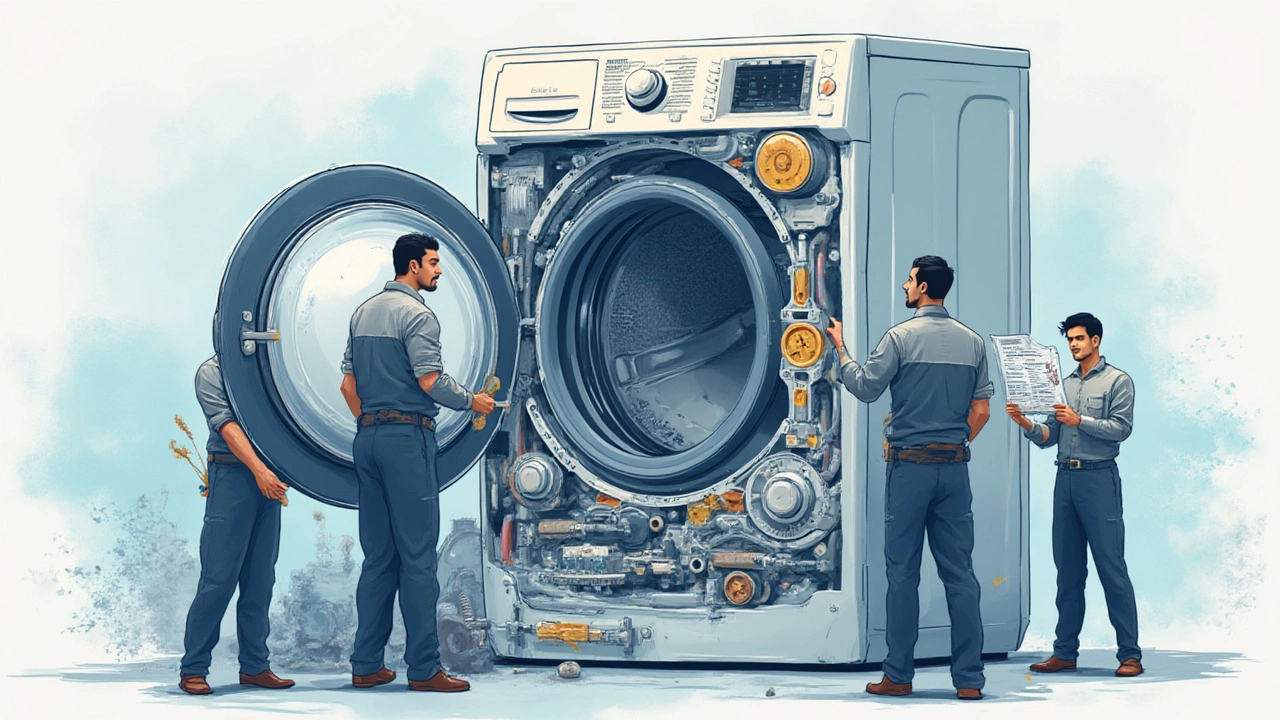
Ever wondered why some washing machines chug along for over a decade while others seem to give up the ghost just after the warranty ends? Back in Brighton, I've heard this question bounce around my neighborhood more than once. It feels a bit like playing the lottery—if you’re lucky, you end up with a faithful GE washer humming quietly in the background for years, but if you’re not, you might be shopping for a new one before your socks have even finished their usual cycle. Home appliances aren't cheap or easy to replace, so knowing what to expect from a GE washing machine can make a pretty big difference for families, renters, and anyone sick of laundromat sprints.
What is the Typical Lifespan of a GE Washing Machine?
Manufacturers like GE don’t exactly stamp an expiration date on their washers. Still, it’s no secret in the appliance world: Most GE washing machines are designed to last about 10 to 14 years, if you treat them decently. Think of it as a long-term relationship—how you care for your appliance can make or break your years together. This estimate isn’t a guess pulled out of thin air. The Association of Home Appliance Manufacturers regularly compiles surveys and user data, pointing out that American-made washers, including GE, have an average life ticking in around that 10-to-14 year span.
Use matters a lot. If you’re running three loads per day for a family of six, the odds are your washer will wear out more quickly compared to someone like my cousin across town who washes his gym kit every other week. GE’s own guidance lines up with the stats: their machines are tested to handle thousands of wash cycles, but every extra cycle chips away at that number. Here’s a table with some real-world data based on independent tests and user feedback seen in the past five years:
| Washing Machine Brand | Average Lifespan (Years) | Typical Use (Loads per Week) |
|---|---|---|
| GE | 11-14 | 5-8 |
| Whirlpool | 10-13 | 5-7 |
| Samsung | 9-12 | 4-7 |
| LG | 11-15 | 4-8 |
The numbers show GE holds its own in the “long haul” club, though of course, that depends on you not treating it like a rugby scrum. The model you pick also shapes the odds. Top-loaders sometimes stretch past the 14-year mark, while front-loaders, with their sleek looks and fancy cycles, may clock out a bit earlier. Costs for repairs can spike quickly in older models too—so at some point, experts usually say if you hit the decade mark and the repair price keeps climbing, it’s probably time for a replacement instead of one more fix.
Factors That Affect GE Washing Machine Longevity
Maybe you’ve bought a washing machine the same year you moved in with your partner, watching it soldier on while everything from kitchen chairs to haircuts changed with the times. But not every washer can stand the test of time so gracefully. Loads, detergent use, water hardness—these things sound boring at first glance, but they’re the reason yourself or someone like my mate down the road might have seen their GE model die before its tenth birthday, while others are still spinning through piles of towels. Let’s drill down into what really matters:
- How Many Loads You Run: The more cycles, the faster the parts wear down. It’s a bit like clocking up miles on your car. If you have little kids or a lot of gym gear, be ready for a shorter ride.
- Level of Maintenance: Clearing the lint, wiping down the drum, checking hoses for splits—easy, but usually skipped. A study by a big UK appliance insurer found that more than half of all washer breakdowns were caused by avoidable issues like blocked filters or tangled hoses.
- Water Quality: Got hard water? That stuff is murder on washing machines. It builds up limescale, which clogs hoses, trashes seals, and causes the washer to strain twice as hard. Areas like Brighton (trust me, I live here) can have pipes loaded with minerals, so a water softener or regular vinegar cleaning cycles help stop breakdowns.
- Detergent Dosage: Using too much soap or the wrong kind? Suds can gum up the system and make sensors go haywire. Always go for a high-efficiency (HE) detergent with newer models and stick to what the manual says, even when it feels like less is not enough.
- Big vs. Small Loads: Always stuffing the barrel to its limits? That overworks the motor and suspensions. On the flip side, running too small a load doesn’t balance the drum, causing thumping and stressing bearings and seals. Aim for that goldilocks amount—not too full, not too empty.
- Voltage Surges: Unexpected power spikes can fry the control board. Simple surge protectors can save your washer’s digital heart (and save you lots of cursing and cash).
Special features can be both a blessing and a curse here. All those snazzy “quick wash” settings, Wi-Fi connections, and ultra-custom wash routines are brilliant until something fries. Electronics are the single biggest failure point after the mechanical parts, especially after the warranty wraps up. If you use the smart functions, keep the software up to date, and disconnect during wild storms if you’re in an area prone to power cuts—trust me, it takes seconds but can save your machine’s memory board.

Pro Tips to Maximize the Life of Your GE Washing Machine
I’ve learned the hard way that a bit of effort up front saves a mountain of headaches later. While Elena rolls her eyes whenever I get “too serious” about cleaning the filter, I’d rather spend ten minutes messing with lint than hundreds at the appliance shop. Check these pro tips to help your GE washer pass that 10-year mark with fewer dramas:
- Check Hoses Every 6 Months: Look for bulges, leaks, or splits—especially where the hose connects to the back of your washer or tap. Replace anything that feels brittle or puffy.
- Clean the Drum Monthly: Run an “empty cycle” with just hot water and white vinegar to break down nasty buildup. If your area is mineral-rich (hello, Sussex!), do this even more often.
- Don’t Slam the Door: Gently close the washer lid or door. Those locks and hinges are more fragile than they look, and snapping one by accident can turn laundry day into a nightmare.
- Wipe Down Gaskets and Seals: Mould looks manky, smells terrible, and shortens your washer’s life. Dry off the door seal with a tea towel after each use—and if you spot black marks, wipe with diluted bleach or a quality mould remover made for appliances.
- Use Only the Detergents GE Recommends: Sound picky, but going rogue with bargain powders or non-HE brands can clog up your machine or wear out the pump.
- Leave the Door Open Between Washes: This helps moisture evaporate and fights off musty smells, which can spread to your clean clothes if you’re not careful.
- Keep Things Level: Washing machines move—even dance—if not sitting on an even surface. Check the feet under your GE washer. If it shakes too much, use a spirit level and adjust.
- Quickly Clean Up Spills on the Control Panel: Water and electronics do not mix. Wipe away drips instead of letting them sneak into the buttons and dials.
- Check and Clean the Detergent Drawer: It attracts grime and old soap scum that ends up right back in your laundry. Pull it out, give it a soak, and scrub it with an old brush now and then.
Some GE models have a self-clean cycle—if yours does, use it when the machine reminds you. If not, that simple “white vinegar on hot” trick works well. Don’t ignore small noises or leaks, either. Catching an ugly rattle or dribble early usually makes for cheap fixes, while waiting tends to tip a simple issue into total breakdown territory.
When to Repair and When to Replace: Making the Smart Choice
When your GE washing machine starts acting up—leaving clothes wet, making weird grinding noises or flashing confusing error codes—it’s tempting to try one more patch-up job. But repair costs add up fast, and sometimes you’re really just buying a few extra months before a bigger failure. The old “50% Rule” still holds: if the repair will run you more than half the price of a new machine and the washer is nearing its expected lifespan (around 10 years), it’s smarter to invest in a replacement. Keep these real-life cues in mind:
- Broken drum bearings—the repair can cost almost as much as a new washer, and it’s a tough fix even for seasoned appliance techs.
- Major electrical faults or fried main control boards—if your model’s out of warranty, replacing the electronic panel is rarely worth the money or wait.
- Water leaking from the bottom or rust spots—signs the internal tub or seals are failing. Once rust gets going, it’s not just ugly, but can spread and destroy moving parts.
- Consistently unbalanced washes—if leveling, redistributing loads, and even professional checks don’t sort it, your internal suspension might be shot.
On the flip side, quick fixes—like clogged inlet filters, snapped belts or broken door latches—are often cheap and easy enough for a keen DIY-er. If you’re hunting for parts, look up your GE model and check availability before giving up. There’s a healthy market for genuine spares, and older GE units tend to have good coverage in the UK and US, which keeps repair costs lower than some more niche brands.
Thinking about eco-friendliness? Replacing a dying washer with a high-efficiency new one often pays off in water and energy savings that add up over the years. The latest GE models use about 30% less water and 25% less electricity than older ones, especially when you use “Eco” settings and cold washes. In Brighton, switching to a newer Energy Star model has knocked about £40 per year off my energy bills. Not trivial, especially when costs everywhere are creeping up.